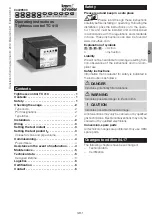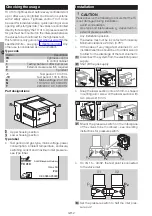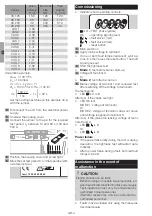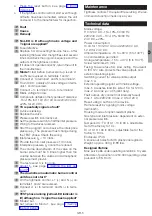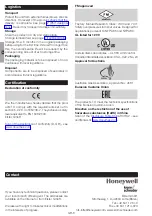
GB-5
D
GB
F
NL
I
E
▷
Press the reset button, see page 4 (Com-
missioning).
▷
If the tightness control will not start even though
all faults have been remedied, remove the unit
and send it to the manufacturer for inspection.
? Fault
! Cause
• Remedy
? No LED is lit although mains voltage and
ϑ
signal are applied?
!
Fuse defective.
•
Replace 5 A slow-acting fine-wire fuse – after
replacing the fuse, start the tightness test several
times and check the program sequence and the
outputs of the tightness control.
•
If it does not operate correctly, return the unit to
the manufacturer.
! Mode :
test before burner start-up is set; L1
and N are reversed on terminals 1 and 2.
•
Connect L1 to terminal 1 and N to terminal 2.
!
For 24 V DC: polarity of mains voltage on termi-
nals 1 and 2 reversed.
•
C to terminal 1 and – to terminal 2.
!
Mains voltage too low.
•
Compare to details on the type label. Tolerance:
-15/+10% for 110/120 V AC and 220/240 V AC,
±20% for 24 V DC.
? TC repeatedly signals a fault?
!
A valve is leaking.
•
Replace the valve.
!
Pressure switch incorrectly set.
•
Set the pressure switch to half the inlet pressure.
!
Wiring to the valves reversed.
•
Start the program and observe the interspace
pressure p
z
. The pressure must change during
the TEST phase. Check the wiring.
!
Inlet pressure p
u
< 10 mbar.
•
Provide the min. inlet pressure of 10 mbar.
!
Interspace pressure p
z
cannot be reduced.
•
The volume downstream of the valve on the
burner side must be 5 times higher than the
volume between the valves and atmospheric
pressure must prevail.
!
The test period t
P
is too long.
•
Adjust t
P
, see page 3 (Setting the test pe-
? The downstream automatic burner control
unit does not start?
!
On the tightness control, L1 (+) and N (–) on
terminals 1 and 2 are reversed.
•
Connect L1 (+) to terminal 1 and N (–) to termi-
nal 2.
? TEST phase running (yellow LED indicator is
lit) although no
ϑ
signal has been applied?
!
Mode 2 set.
•
Set jumper to Mode 1, see page 3 (Setting
the test instant).
Maintenance
Tightness controls TC require little servicing. We rec-
ommend a function check once a year.
Technical data
Mains voltage:
110/120 V AC, -15/+10%, 50/60 Hz,
220/240 V AC, -15/+10%, 50/60 Hz,
24 V DC, ±20%.
Power consumption:
10 VA for 110/120 V AC and 220/240 V AC,
1.2 W for 24 V DC.
Ambient temperature: -15 to +60°C (5 to 140°F),
no condensation permitted.
Storage temperature: -15 to +40°C (5 to 104°F).
Screw terminals 2.5 mm
2
.
Fusing: fine-wire fuse 5 A, slow-acting, H pursuant
to IEC 127, also protects the valve outputs and
external operating signal.
Switching current for valves/enable output:
max. 5 A.
External operating signal: with mains voltage,
max. 5 A resistive load (UL listed: 5 A for 120 V),
max. 2 A at cos
ϕ
= 0.35 (pilot duty).
Fault output: dry contact (not internally fused),
max. 1 A for 220/240 V, max. 2 A for 120 V.
Reset: using a button on the device.
Remote reset: by applying mains voltage
(terminal 5).
Housing made of impact-resistant plastic.
Gas type and inlet pressure: dependent on exter-
nal pressure switch.
Test period t
P
: TC 410-1: 10 to 60 s, adjustable.
Set at the factory to 10 s.
TC 410-10: 100 to 600 s, adjustable. Set at the
factory to 100 s.
Enclosure: IP 40.
5 knock-out holes for M16 plastic cable glands.
Weight: approx. 400 g (0.88 lbs).
Designed lifetime
Max. service life under operating conditions: 10 years
after date of production or 250,000 operating cycles
pursuant to EN 1643.

